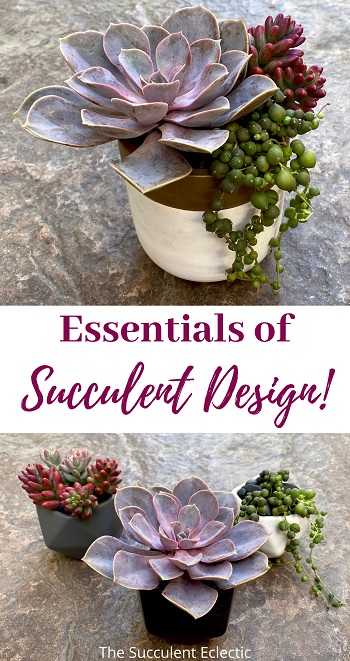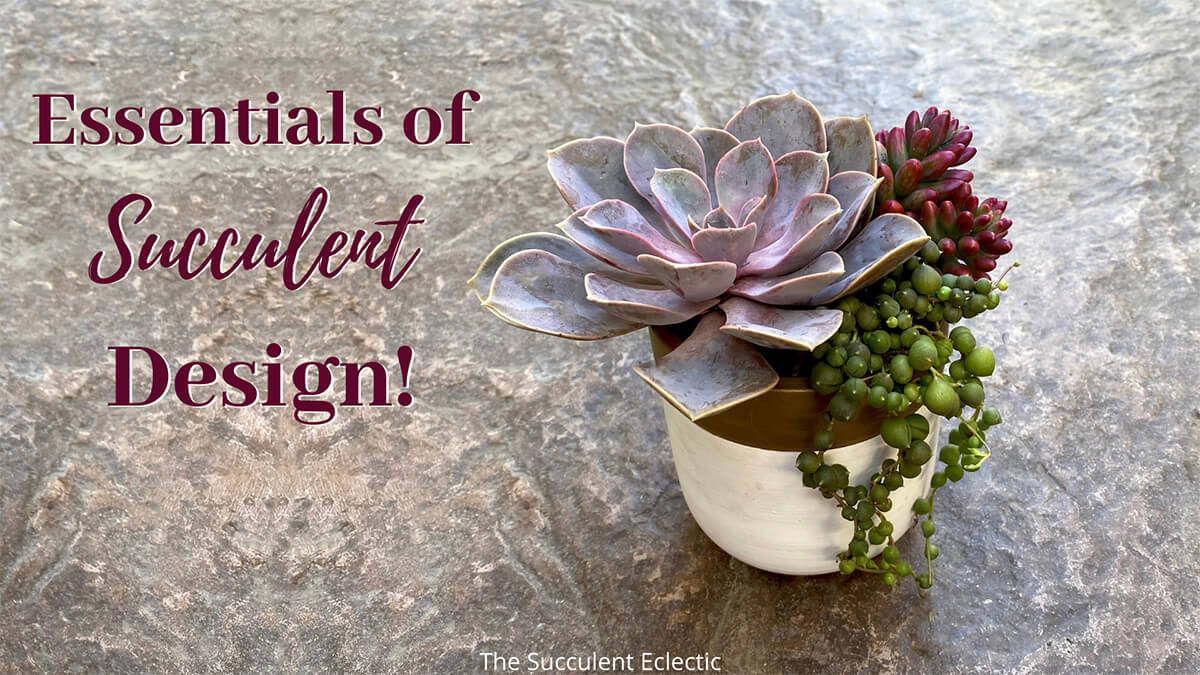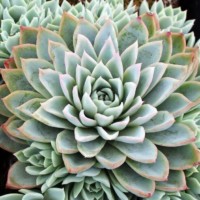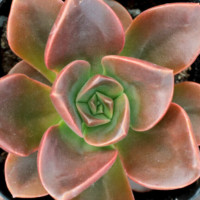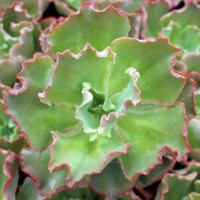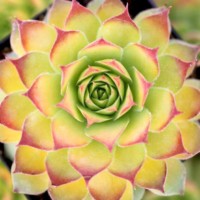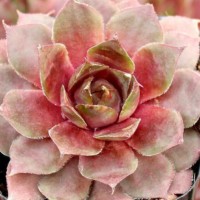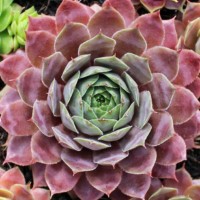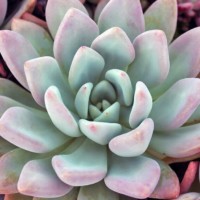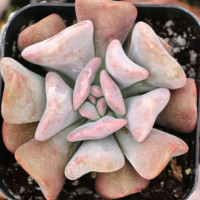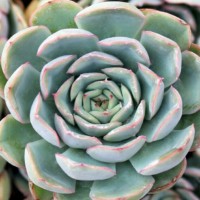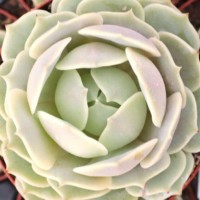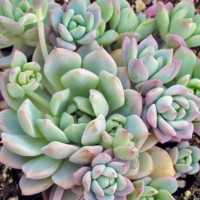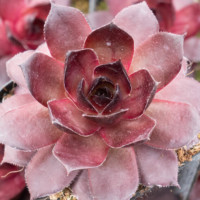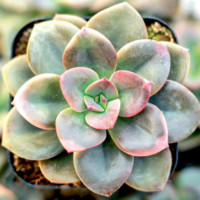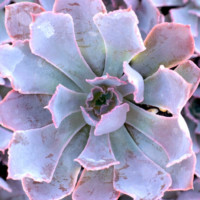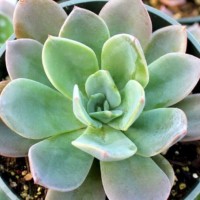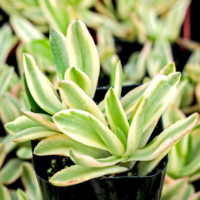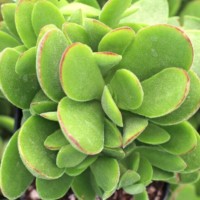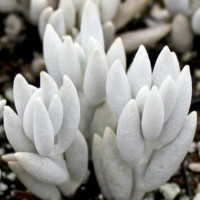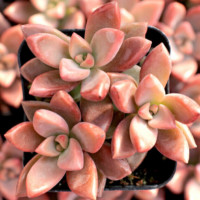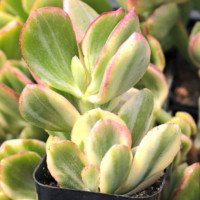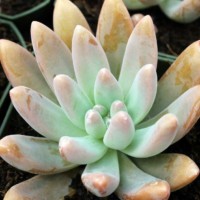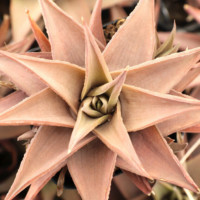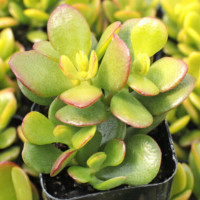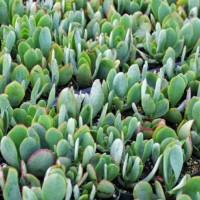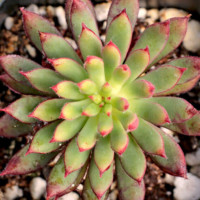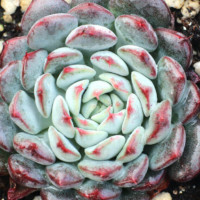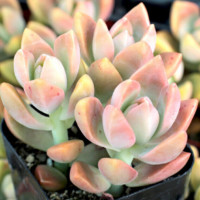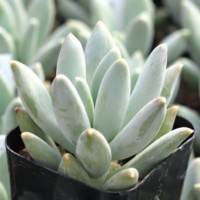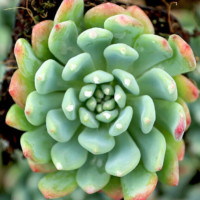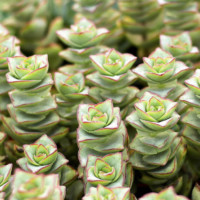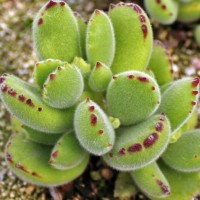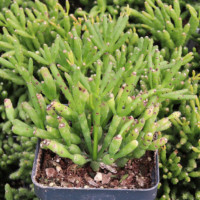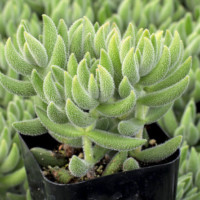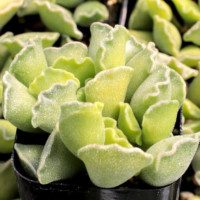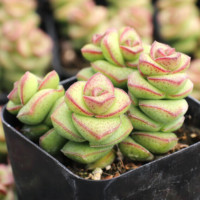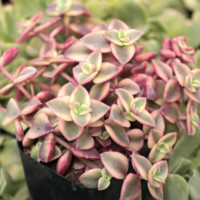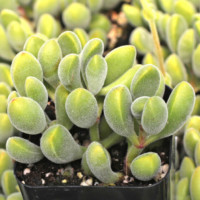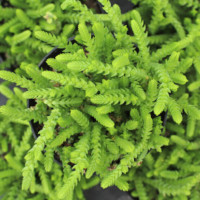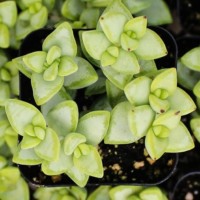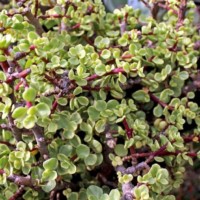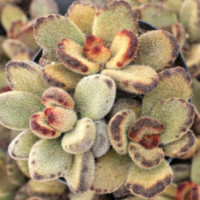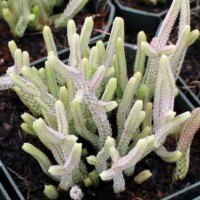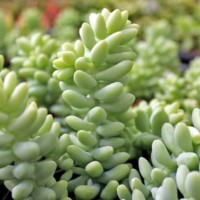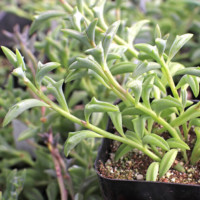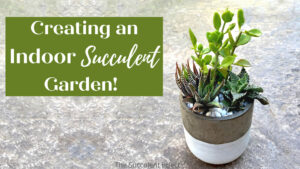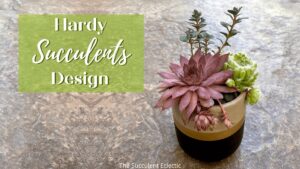This is the first in what will be a series of posts devoted to making succulent design simple and successful. We have a lot to cover! In this series, we will take a look at visual design elements like color, shape, and texture, as well as design principles like creating a focal point, repetition, scale, and contrast. But that’s only half of the equation when we think of succulent design. Unlike cut flower bouquets, where each flower has the same need for water to postpone death, our succulent designs are living sculptures. Each plant in the succulent arrangement has its own specific water needs, sun exposure needs, cold hardiness, growth rate, and dormancy issues. Unless you plant succulents with similar care needs together, your arrangement won’t last long.
Succulent Design Made Simple!
In this Post We'll Cover:
{Please note, some links in this post may be affiliate links to sites that pay me a small commission if you click on the link and make a purchase. This commission is at absolutely no cost to you. I only recommend products and companies that I have worked with and truly love! ~Kat}
I absolutely love the work of accomplished succulent designers like Cindy Davidson and teachers like Debra Lee Baldwin. But, as much as I have studied their work and that of many others, I have never found the design aspects broken down into simple steps that are easy for non-designers to follow. We’re going to do that. By focusing on choosing just three plants for an arrangement, we can zoom in on the specific design elements used in choosing each one. And we’ll make sure to choose only from succulent varieties that grow well together. This, too, has been missing in the sources I’ve studied. Yes, a Haworthia fasciata and an Echeveria gibbiflora look striking together today. But their sun exposure needs are so different that they will never be happy growing in the same pot together. So, we’re going to tackle choosing specific plants with common care needs for your succulent arrangement, too.
It has long been a goal of mine to develop a guide to succulent design that explains design elements simply while gathering specific plant varieties that will thrive together. Every time I have discussed this with another person in the succulents field, the general answer I received was a half-smirk and a “Good luck with that!” Then, one day, I was speaking with Matts Jopson, the owner of Mountain Crest Gardens, and I mentioned this idea. He immediately saw the value in the concept, and he wanted to offer it to his customers. So —
Announcing MCG Succulent Trifect Kits
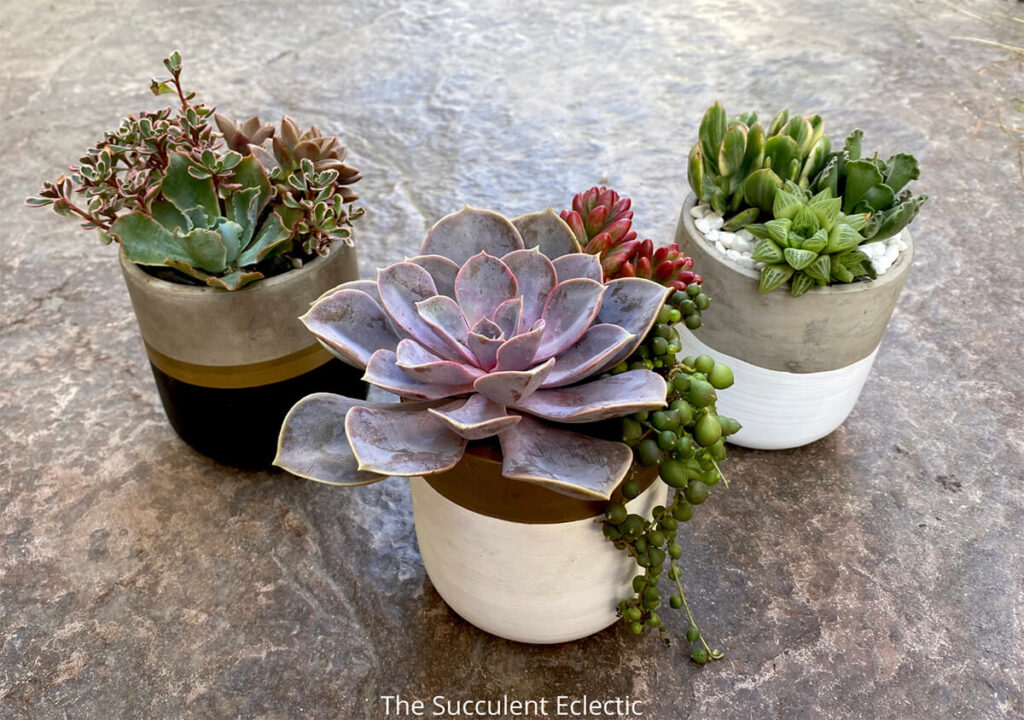
I am thrilled to announce that I have teamed up with Mountain Crest Gardens to introduce an all-new product line that we are calling MCG Succulent Trifecta™ Kits. Succulent Trifecta Kits are trios of succulent plants that complement one another both in terms of design elements and care needs. Composed of the Core plant (the heart of the design), the Complement plant (that builds on the theme), and the Character plant (that adds a whimsical texture and makes the arrangement memorable), they help make succulent design both simple and successful!
Choosing from the hundreds of varieties available from Mountain Crest Gardens, I have created nine different named Succulent Trifecta Kits, each with its own distinct theme. Each includes three 2.0” potted succulents (specific plants chosen by MCG staff from the select varieties I chose that fit the theme and growing conditions), extra potting soil to help transplant into a larger container, a free 4.0” plastic pot (optional), and the ability to easily add on nicer containers, top dressing, and other accessories. Each MCG Succulent Trifecta™ Kit is based on one of my designs, but specific succulents included may vary!
In addition, we have set up four Build-Your-Own Trifecta Kits, where you can follow my design guidelines to create any look you want, secure in the knowledge that all the plants available to choose from will grow together and thrive! Woo-HOO!
What is a Succulent Design Trifecta
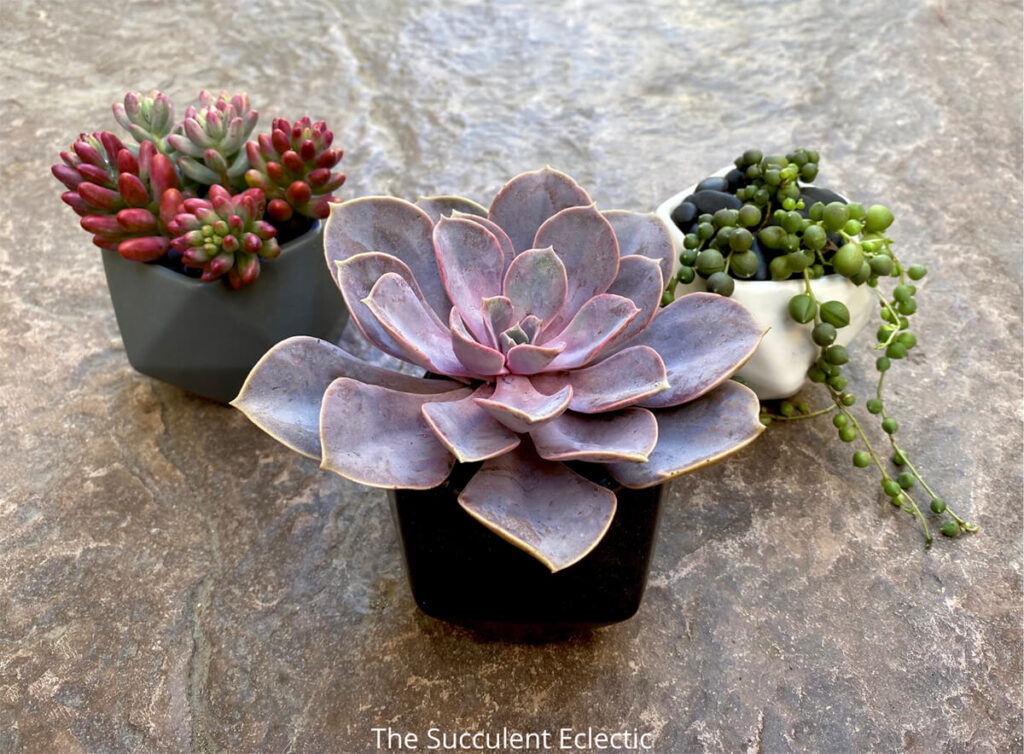
What is a trifecta?
A trifecta is a winning combination of three good things that, in combination, become truly great! And that is the theory behind this approach to succulent design. I have carefully chosen the plants for each succulent trifecta using two guidelines. First, the three succulents must grow well together in the same conditions. Next, each of the three should enhance and showcase the best attributes of the others. Together, they are even more lovely than on their own. This is succulent design made simple! Each MCG Trifecta will thrive in the same container and look absolutely sensational! Or plant them in separate, complementary pots in the garden or on a windowsill. Just abide by the recommended sun exposure and hardiness zones. Are you ready to score your first trifecta?
Anatomy of a Succulent Trifecta Design
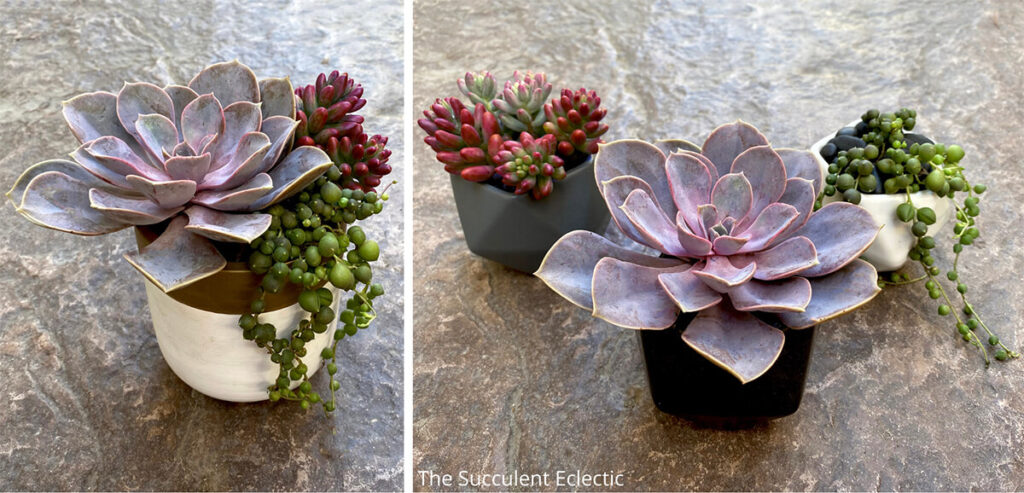
You have likely come across the succulent design recipe with a “thriller, filler, and spiller,” right? While I think it can be a useful guide, if you understand the roles for each, it is also quite limiting. After all, what to do with an arrangement that doesn’t include a “spiller,” as most of my trifectas do not? Instead, let’s build our designs around three necessary ingredients — the Core, a Complement, and a Character.
The Core of any succulent design is the focal point, the one plant all eyes are drawn to first. This is the heart of the succulent arrangement. It is the center of attention the arrangement is designed around. The Complement is chosen to enhance the beauty of the Core, to complement its form, color, or texture with its own. The Character adds a sense of whimsy with an unusual texture that pulls the design together and makes it memorable.
For this design, the Classic Beauties Trifecta, I started with the rich mauve rosette of Echeveria Perle von Nurnberg. The unusual coloring and exquisite, flower-like form make it the focal point or the Core of this succulent arrangement. The Sedum rubrotinctum ‘Aurora’ repeats the rosy color and introduces a playful texture that echoes the curves of the PvN’s leaves. Because it enhances and highlights the beauty of the Core, the Sedum is the Complement of this arrangement. Senecio rowleyanus ‘String of Pearls’ repeats the jellybean-like shape of the Sedum’s leaves and intensifies it, forming whimsical “pearls” that tumble over the side of the pot. Contributing charm to the arrangement and making it memorable, the Senecio is the Character of this succulent design. When you plant the Classic Beauties Trifecta, it will thrive in bright, partial-day sun outdoors. The arrangement is hardy to zone 10 (30° F / -1° C).
Elements and Principles of Succulent Design
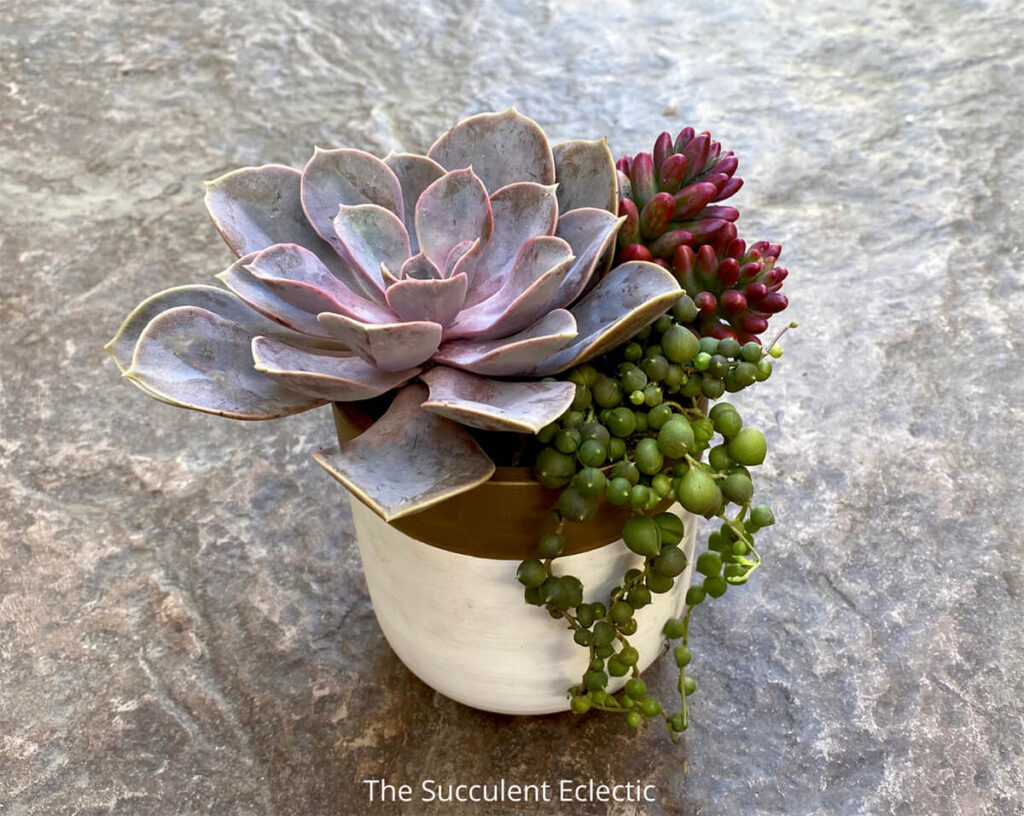
Succulent design is made up of design elements and principles. The elements are the visual qualities of the plants you choose, like their color, form, and texture. The principles are the concepts that guide your selection and placement of the plants. Creating a focal point, repetition, scale, and contrast are examples of design principles. Design elements and principles can be combined and used together. For instance, you might repeat the color of one plant with another in the same color. Or you might use two plants with very different textures to contrast with one another. Throughout this series of posts about succulent design, we’ll focus on a single design principle in each and illustrate it using a different succulent trifecta.

The design principle I focused on in creating this arrangement is repetition. All types of design incorporate repetition. Many songs use the repetition of the refrain to reinforce the theme and mood of the song. Repeating notes and musical phrases helps to form a melody. When you match your shoes to your outfit, you are repeating the color to tie the look together. Architects, graphic designers, and interior designers create visual harmony by repeating strong visual elements. In the image above, the woman holding balloons, there are many repetitions, right? Her red lipstick repeats the red of her plaid dress. The blue balloons repeat the blue of the sky. But the single point that really makes this picture special is the single red balloon, repeating the color of her lips and dress. Repetition creates rhythm and patterns that draw disparate elements together to create harmony.
I started with the lovely mauve Echeveria Perle von Nurnberg as the Core of this succulent arrangement. I added the Sedum rubrotinctum ‘Aurora’ because its leaves develop a burgundy blush that complements the Echeveria by repeating its color. I also repeated shapes in this succulent design. The round “pearls” of the Senecio rowleyanus ‘String of Pearls’ echo or repeat the rounded, oblong, jellybean-like leaves of the Sedum. When you choose succulents that repeat color, shape, or form, you know they will look good together! But will they grow well together? Remember, that’s the second half of the equation we’re solving, so less see how to choose plants that grow well together.
Understanding Growing Conditions of a Succulent Trifecta
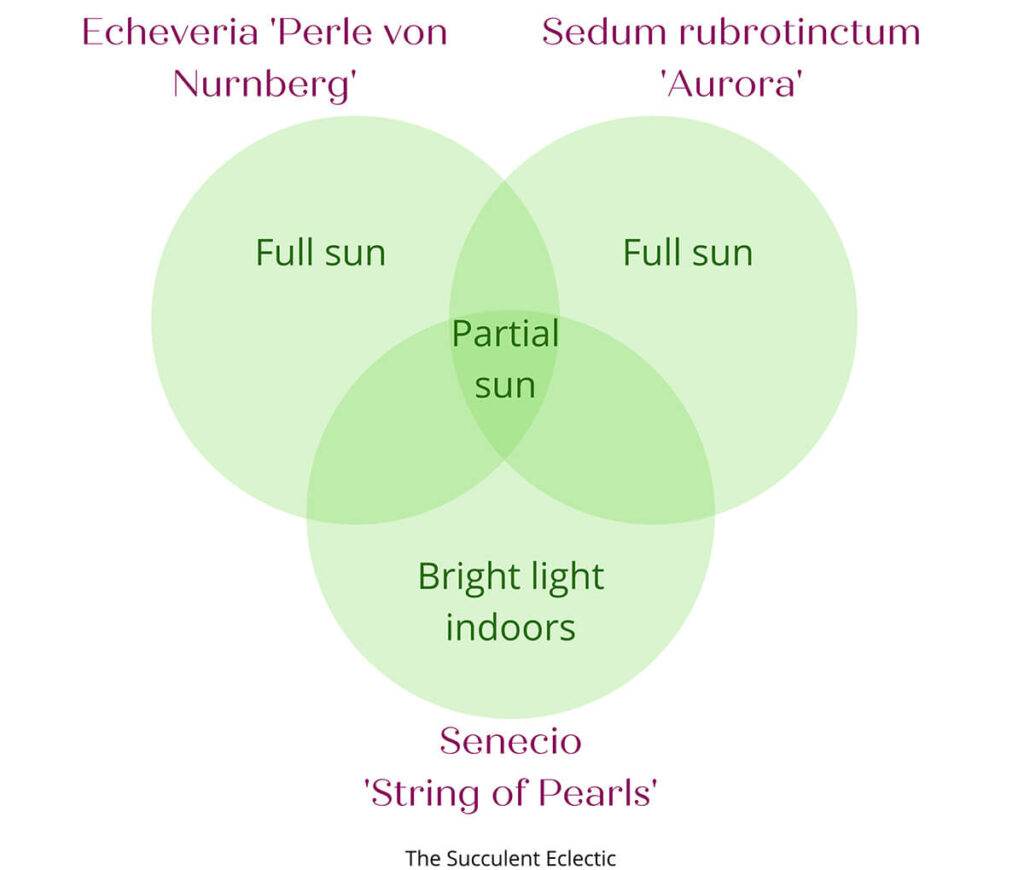
When you plant a group of succulents in the same pot based only on how they look together, finding the right growing conditions for them can mean a lot of trial and error, with several unhappy plants. Instead, if your succulent arrangement is based on plants with common needs, it is much easier to keep them healthy and happy together.
When evaluating the sun exposure or the cold hardiness of a group of plants, a Venn diagram is the perfect way to illustrate the sweet spot you’re seeking. Most plants have a range of lighting conditions or climate zones they grow well in. Where the needs overlap, different plants can grow well together. Here, we see Senecio rowleyanus “String of Pearls’ recommended lighting: bright light indoors, filtered light or partial sun — where any lighting from bright indoor light to partial sun outdoors gives the plant what it needs. Sedum rubrotinctum ‘Aurora’ and Echeveria ‘Pearle von Nurnberg’ both grow well in full sun to partial sun. So, where the three plants’ lighting conditions overlap — partial sun — all three will thrive.
The process is the same for determining the hardiness zones of the succulent arrangement. If you plant a succulent that is hardy to zone 8 (meaning it is hardy in zones 8, 9, and 10) with one that is hardy to zone 5 (hardy in zones 5, 6, 7, 8, 9, and 10), then the two plants together are hardy to zone 8, (hardy in zones 8, 9, and 10). Choosing plants that grow well together then becomes a simple matter of research.
Balancing Watering Needs and Dormancy in Succulent Designs
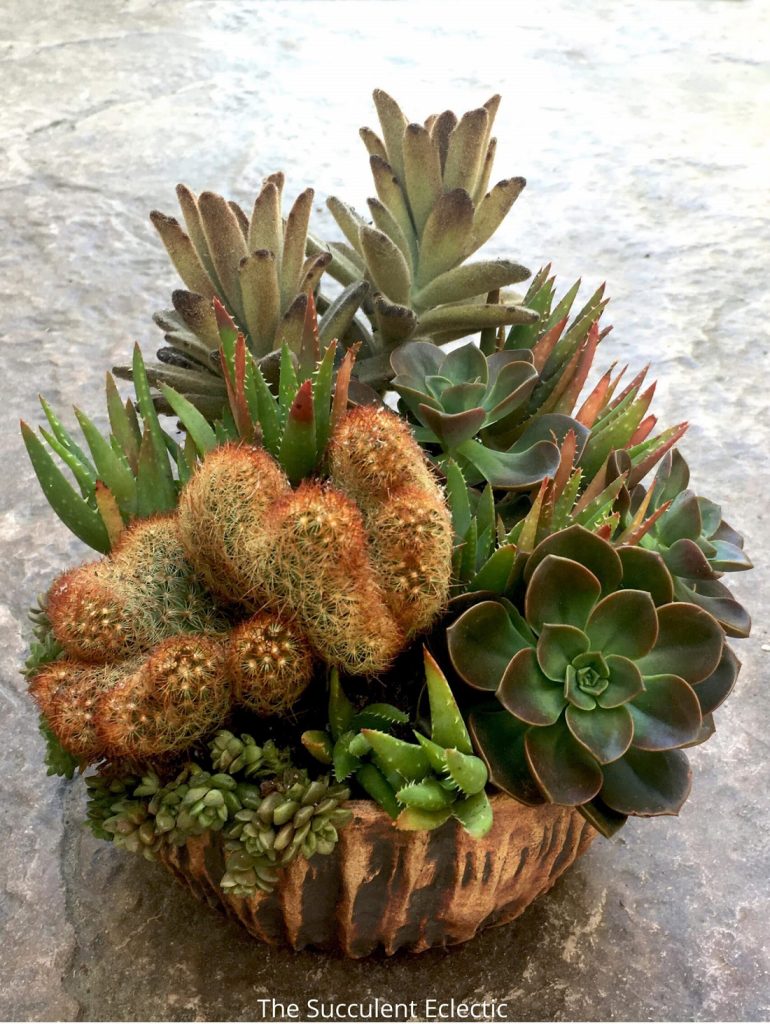
Here, you see a more complex succulent design I created using repetition. See how the dark Echeveria ‘Melaco’ repeats the dark color of the planter while the crested cactus repeats the lighter color? The strong, slim, vertical lines of the Aloe ‘Crosby’s Prolific’ also repeat the vertical lines of the pot’s texture. All of the plants chosen thrive in partial sun in zone 10. So — we’re done, right? Not so fast… The succulents all need much more water than the cactus can take and still survive. And Aloes are dormant in summer and growing in winter, exactly the opposite of Echeveria! So, how can this possibly work?
When you close-plant succulents like this, with many plants tight together in a single pot, proper watering actually gets easier. With many roots in the soil, eager to drink, each succulent quickly takes up the water that it needs, so the soil never remains wet. When some of the succulents are dormant, those that remain actively growing take up the water just fine. The entire arrangement doesn’t need to be watered quite as often, and all the plants remain healthy.
The same principles work well for succulents that like more or less water. Those that need more water take up more, while those that want less water take less. It all evens out nicely among close-planted succulents. But there are a couple of notable exceptions. Cactus need much drier conditions than other succulents. There is a specific technique for planting cacti with succulents. Essentially, you plant the cactus with the top 2/3 of its rootball exposed above the soil line, so its roots simply don’t take in so much water. I know this sounds strange, but it truly works! This crested Mammillaria elongata ‘Copper King’ cristata has more than doubled in size and beauty while growing in this arrangement for two years!
The other tricky succulents to consider are Lithops and some other mesembsSucculent members of the Aizoaceae family that resemble ston... More. These adorable, stone-like succulents have such extreme watering regimens combined with long taproots and a tendency to rot. Because Lithops must be left completely dry for months at a time, I don’t consider them good choices to plant with other succulents. It’s possible they, too, can grow well with mixed succulents if you follow a little trick — I just don’t know what that trick is! 🙂
Design Your Own Succulent Arrangement
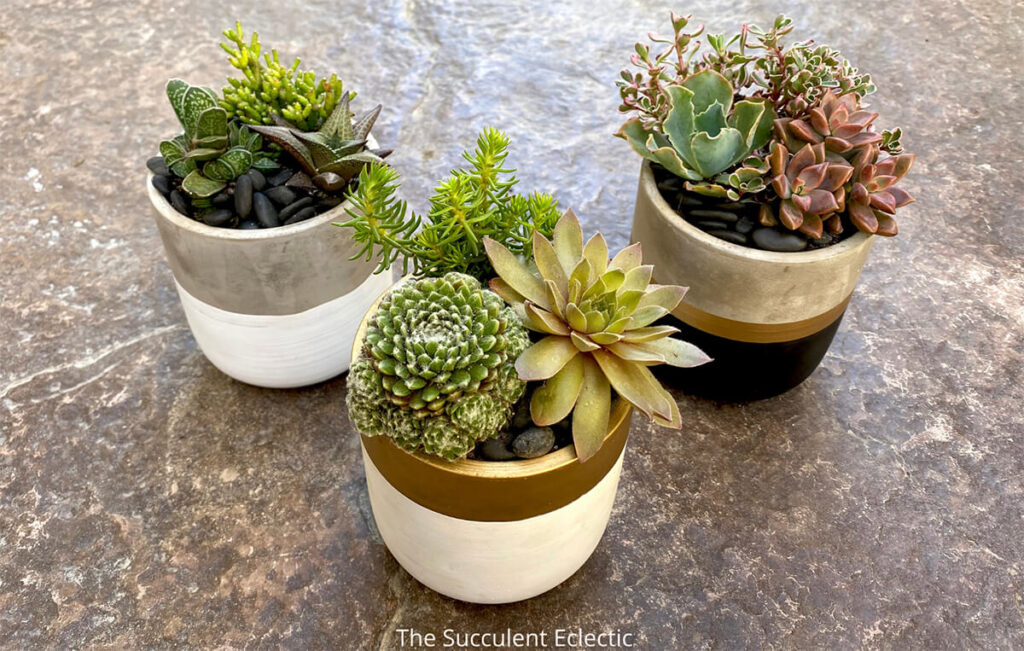
Of course, you haven’t read this entire blog just to put together the same three plants in a succulent arrangement, right? You want to know how to put together your own choice of three plants, and in time, we’ll add more to the three. So, I have done the research for you to find 45 different succulents that will all grow well together in partial sun and hardy in zone 10. That is the purpose behind the Build-Your-Own Trifecta Kits. Click the link to see the available options, or check them out here.
I have divided these succulents into 3 sections: Core succulents, Complement, and Character. Simply choose one from each grouping to create your own trio or to design a larger succulent arrangement. Of course, you might disagree with my aesthetic evaluations, but it’s a place to start and organize these 45 plants. Look through them, and consider which you think will complement one another by repeating a color, shape, or texture.
Core Succulents – Partial Sun/ Zone 10 (30° F / -1° C)
Remember, the Core succulent is the heart of your design, the focal point, the star of the show.
Complement Succulents – Partial Sun/ Zone 10 (30° F / -1° C)
Choose a Complement that enhances the Core succulent you’ve chosen. Try repeating its color, shape, or texture.
Character Succulents – Partial Sun/ Zone 10 (30° F / -1° C)
Finally, choose a Character succulent, one whose whimsical texture helps to tie your succulent design together and make it memorable!
Whew! That was a lot to cover. Thanks so much for hanging in there with me! Additional posts in this series will each cover a single design principle behind a different succulent arrangement. Other arrangements will include indoor succulents, cold-hardy varieties, and those for full sun. I think the next one we cover will be an indoor succulent arrangement that will grow in any home. That succulent design is based on contrast and texture. And each new post will have a bunch of other succulents listed that will grow in the same conditions. But the introduction of the MCG Succulent Trifecta™ Kits and information about caring for an arrangement has all been done. I’ll link future posts back to this one so they won’t all run so long.
Now, I’d love to hear what you think! Please take a moment to leave a comment telling me where you are on your succulent design journey. Do you think the Core, Complement, and Character will help you to create your succulent arrangements? Is something unclear? I’d love to know!
Because life is just better with succulents!
P.S. For more information on succulent design, care, and crafts, please subscribe! I’ll send you my FREE e-course, 7 Steps to Succulent Success! Thanks!
P.P.S. Why not join my Facebook Group for succulent lovers? We talk about succulent care, propagation, succulent identification, and design. It’s a warm and welcoming group that would love to meet you!
